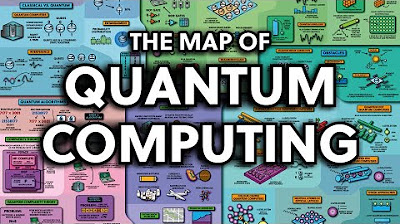How to program a quantum computer using Qiskit
Summary
TLDRThis video offers an introduction to quantum computing and coding with Qiskit, a popular quantum software development kit based on Python. The presenter explains the basics of qubits, superposition, and entanglement, then demonstrates how to write a simple quantum program using Qiskit. The program involves creating a quantum circuit with two qubits, applying a Hadamard gate for superposition and a control not gate for entanglement, followed by measurements. The video highlights the 50/50 probability outcomes of 00 or 11 due to entanglement. It also mentions higher-level Qiskit features, such as machine learning packages, to integrate quantum capabilities into classical applications.
Takeaways
- 🔍 In the previous video, quantum computing and its unique features were discussed.
- 💻 Developers are interested in how to write code for quantum computers on common computers.
- 🔄 Quantum computers use qubits, which can represent 0, 1, or any linear combination of both, known as superposition.
- 🌀 Multiple qubits can be entangled, meaning their states become strongly correlated.
- ⚙️ To manipulate qubit states, quantum gates are applied, similar to classical logic gates.
- 🛠️ Qiskit is a widely used quantum software development kit (SDK) based on Python.
- 📐 A simple Qiskit program involves creating a quantum circuit with quantum and classical registers.
- ⚡ Gates like the Hadamard gate (for superposition) and the CNOT gate (for entanglement) are applied to qubits.
- 📏 Measurements are done using the 'measure all' function to get the results.
- 📊 Running the program multiple times shows a 50% chance of outputs being 00 or 11, due to superposition and entanglement.
- 🔬 Qiskit also offers higher-level algorithms and packages for tasks like machine learning, which can integrate with classical algorithms.
- 📈 The quantum kernel class in Qiskit can be used for training and testing data, enhancing classical applications.
Q & A
What is the main focus of the video script?
-The video script focuses on explaining quantum computing concepts and how to write a simple quantum program using Qiskit, a quantum software development kit based on Python.
What are the key differences between classical bits and qubits?
-Classical bits can be either 0 or 1, while qubits can be 0, 1, or any linear combination of the two, which is known as superposition. Additionally, qubits can be entangled, meaning the state of one qubit can be strongly correlated with another.
How does the Hadamard gate affect a qubit?
-The Hadamard gate puts a qubit into a superposition state, giving it an equal probability of being measured as 0 or 1.
What is the purpose of the control not gate (cx) in quantum computing?
-The control not gate is a conditional two-qubit gate that flips the state of the target qubit if the control qubit is in state 1. It is used to create entanglement between qubits.
Why are classical registers used in quantum circuits?
-Classical registers are used to store the measured results of qubits. They allow quantum information to be brought back into the classical world for further processing or analysis.
What is the significance of entanglement in quantum computing?
-Entanglement is significant because it allows the states of multiple qubits to be strongly correlated. This property is fundamental for quantum algorithms and quantum information processing.
How does the 'measure all' function work in Qiskit?
-The 'measure all' function in Qiskit is used to perform measurements on all qubits in a quantum circuit, which collapses their superposition states and gives classical output results.
What is the expected output when running the simple quantum program described in the script multiple times on an ideal quantum computer?
-The expected output is a 50% chance of the results being 00 and a 50% chance of it being 11. The program will never output 01 or 10 due to the entanglement of the qubits.
How does Qiskit's higher-level algorithms package for machine learning work?
-Qiskit's higher-level algorithms package for machine learning includes pre-built classes like a quantum kernel class. This class can be used to train and test data, and then the trained quantum kernel can be passed into a classical algorithm like support vector classification from scikit-learn to accelerate classical applications.
What is the relationship between Qiskit and Python?
-Qiskit is a quantum software development kit based on Python, making it accessible for developers who are familiar with Python or are willing to learn it.
Why is it important to bring quantum information back into the classical world?
-It is important because most of the applications and systems we interact with are classical. Bringing quantum information back into the classical world allows for the integration of quantum computing with existing technologies and systems.
Outlines

This section is available to paid users only. Please upgrade to access this part.
Upgrade NowMindmap

This section is available to paid users only. Please upgrade to access this part.
Upgrade NowKeywords

This section is available to paid users only. Please upgrade to access this part.
Upgrade NowHighlights

This section is available to paid users only. Please upgrade to access this part.
Upgrade NowTranscripts

This section is available to paid users only. Please upgrade to access this part.
Upgrade NowBrowse More Related Video

Why Quantum Algorithms? — Programming on Quantum Computers — Coding with Qiskit S2E1

Computação Quântica - Fundamentos e Aplicações - Aula 06

The Map of Quantum Computing - Quantum Computing Explained

mod02lec12 - Quantum Computing Concepts: Entanglement and Interference - Part 2

mod03lec16 - Quantum Algorithms: Bernstein Vazirani Algorithm

What is Quantum Computing and why should we care?
5.0 / 5 (0 votes)